Workplace Law Assignment: Analysis of Annie's Employment and Contract
VerifiedAdded on 2023/06/03
|10
|2136
|428
Report
AI Summary
This assignment analyzes a workplace law case involving Annie, a Vietnamese migrant working at Chinatown Restaurant. The report examines the validity of her employment contract, considering her migrant status, potential misrepresentation, and the meeting of minds. It then assesses whether Annie is an employee or an independent contractor, even after her resignation, using the control test, integration test, and multi-factor test. Finally, the report identifies potential breaches of the Fair Work Act 2009, specifically regarding sham contracts and misrepresentation by Chinatown Restaurant, which attempted to reclassify Annie as an independent contractor to avoid employer obligations. The analysis provides a detailed legal perspective on Annie's employment situation and the relevant legislation.

Running Head: BUSINESS AND CORPORATION LAW 0
Workplace Law
10/18/2018
Student’s Name
Workplace Law
10/18/2018
Student’s Name
Paraphrase This Document
Need a fresh take? Get an instant paraphrase of this document with our AI Paraphraser
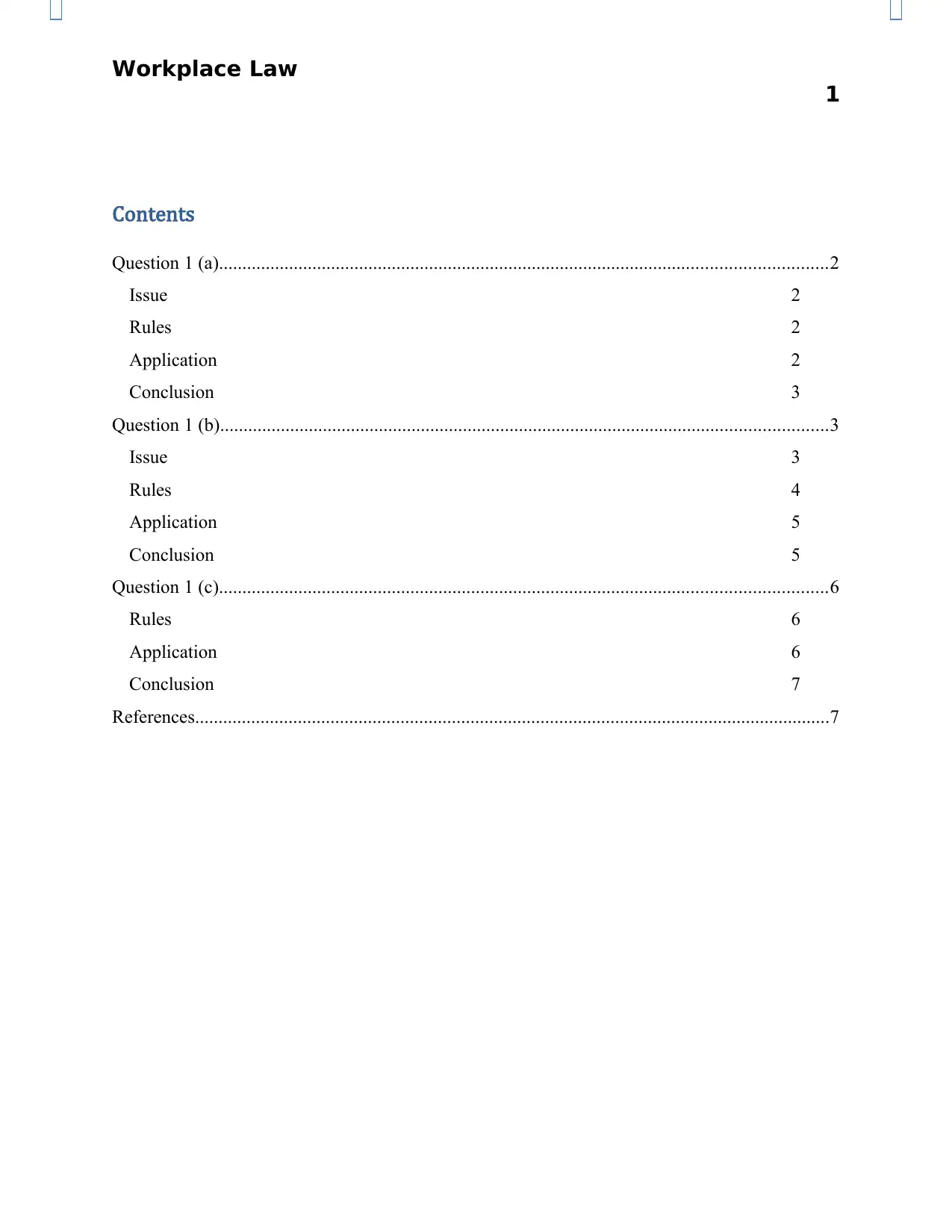
Workplace Law
1
Contents
Question 1 (a)..................................................................................................................................2
Issue 2
Rules 2
Application 2
Conclusion 3
Question 1 (b)..................................................................................................................................3
Issue 3
Rules 4
Application 5
Conclusion 5
Question 1 (c)..................................................................................................................................6
Rules 6
Application 6
Conclusion 7
References........................................................................................................................................7
1
Contents
Question 1 (a)..................................................................................................................................2
Issue 2
Rules 2
Application 2
Conclusion 3
Question 1 (b)..................................................................................................................................3
Issue 3
Rules 4
Application 5
Conclusion 5
Question 1 (c)..................................................................................................................................6
Rules 6
Application 6
Conclusion 7
References........................................................................................................................................7

Workplace Law
2
Question 1 (a)
Issue
To check that whether Annie is able to be a part of a valid employment contract or not.
Rules
People need to have the required the capacity to enter into a contract. In general, people who are
not a citizen of Australia can build up a contract in this nation. The problem is with employment
contracts as a person who is not resident of Australia is likely to be restricted by developing any
contract of employment in the nation (Waarden, 2018). In the case of migrants, the law says that
such people are not allowed to be employed in Australia except in those cases where terms of
their visa allow the same. In addition to this, under a common law, it is a rule that a person who
has not attained the age of 18 years at the time of entering into a contract, he/she cannot be held a
party of a valid contract.
Further, in addition to this, there must not be the existence of any unlawful term in a contract. A
contract cannot be held valid if the same consist one or more unlawful term. Misrepresentation is
one of the kinds of unlawful term. It is a situation where a person misrepresents an important fact
to the other party of the transaction with the intention to seek his/her consent (E-Law Resources,
2018). Such representation can be fraudulent or innocent. Meeting of minds is also necessary for
the development of a valid contract. If parties are not clear with the intention of each other, a
valid contract cannot exist in a transaction (Morgan, Bauer, Flowers and Morrissey, 2017).
Application
In the given case, the person named Annie was migrant for Australia as she belongs to China
originally. She moved to Australia and started working in Chinatown Restaurant. According to
2
Question 1 (a)
Issue
To check that whether Annie is able to be a part of a valid employment contract or not.
Rules
People need to have the required the capacity to enter into a contract. In general, people who are
not a citizen of Australia can build up a contract in this nation. The problem is with employment
contracts as a person who is not resident of Australia is likely to be restricted by developing any
contract of employment in the nation (Waarden, 2018). In the case of migrants, the law says that
such people are not allowed to be employed in Australia except in those cases where terms of
their visa allow the same. In addition to this, under a common law, it is a rule that a person who
has not attained the age of 18 years at the time of entering into a contract, he/she cannot be held a
party of a valid contract.
Further, in addition to this, there must not be the existence of any unlawful term in a contract. A
contract cannot be held valid if the same consist one or more unlawful term. Misrepresentation is
one of the kinds of unlawful term. It is a situation where a person misrepresents an important fact
to the other party of the transaction with the intention to seek his/her consent (E-Law Resources,
2018). Such representation can be fraudulent or innocent. Meeting of minds is also necessary for
the development of a valid contract. If parties are not clear with the intention of each other, a
valid contract cannot exist in a transaction (Morgan, Bauer, Flowers and Morrissey, 2017).
Application
In the given case, the person named Annie was migrant for Australia as she belongs to China
originally. She moved to Australia and started working in Chinatown Restaurant. According to
⊘ This is a preview!⊘
Do you want full access?
Subscribe today to unlock all pages.

Trusted by 1+ million students worldwide
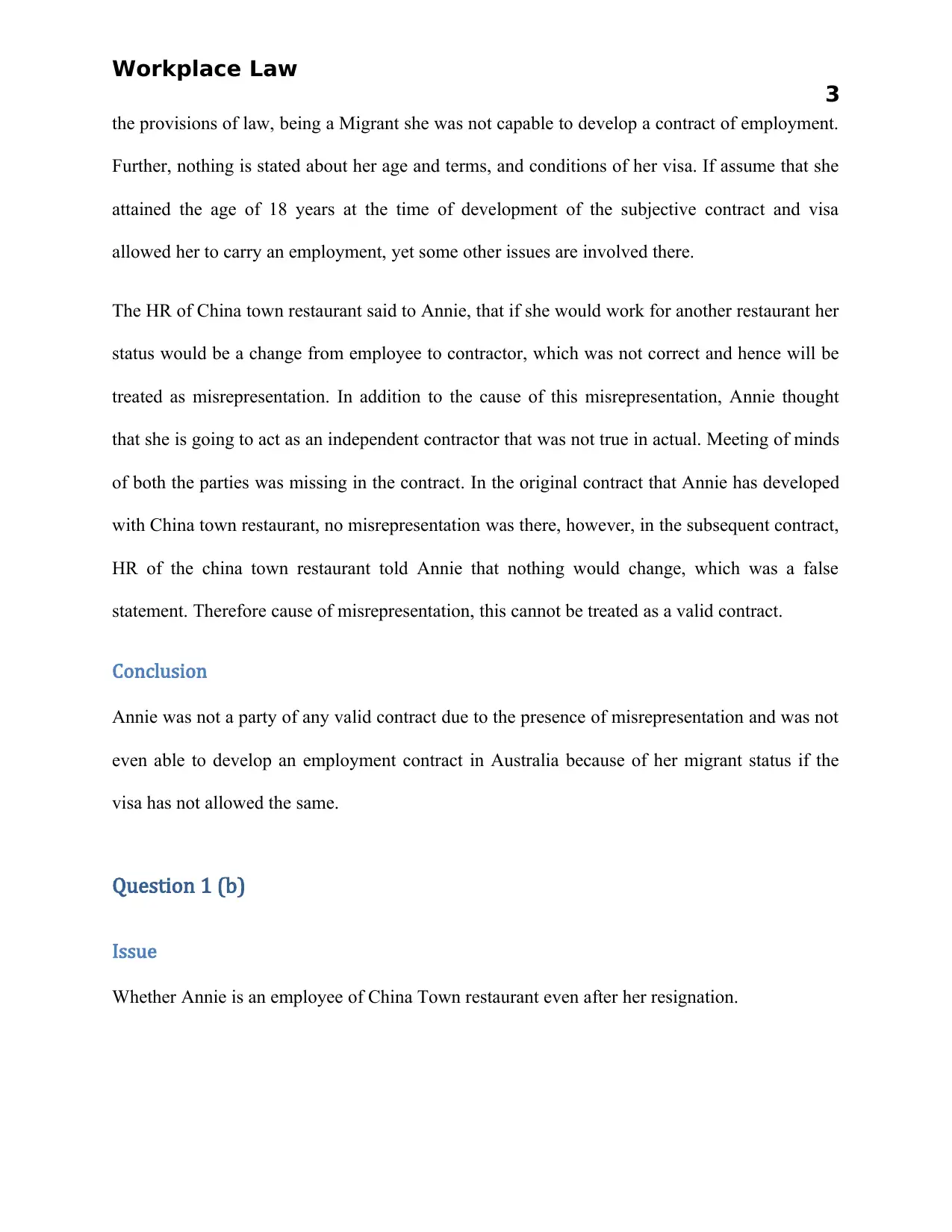
Workplace Law
3
the provisions of law, being a Migrant she was not capable to develop a contract of employment.
Further, nothing is stated about her age and terms, and conditions of her visa. If assume that she
attained the age of 18 years at the time of development of the subjective contract and visa
allowed her to carry an employment, yet some other issues are involved there.
The HR of China town restaurant said to Annie, that if she would work for another restaurant her
status would be a change from employee to contractor, which was not correct and hence will be
treated as misrepresentation. In addition to the cause of this misrepresentation, Annie thought
that she is going to act as an independent contractor that was not true in actual. Meeting of minds
of both the parties was missing in the contract. In the original contract that Annie has developed
with China town restaurant, no misrepresentation was there, however, in the subsequent contract,
HR of the china town restaurant told Annie that nothing would change, which was a false
statement. Therefore cause of misrepresentation, this cannot be treated as a valid contract.
Conclusion
Annie was not a party of any valid contract due to the presence of misrepresentation and was not
even able to develop an employment contract in Australia because of her migrant status if the
visa has not allowed the same.
Question 1 (b)
Issue
Whether Annie is an employee of China Town restaurant even after her resignation.
3
the provisions of law, being a Migrant she was not capable to develop a contract of employment.
Further, nothing is stated about her age and terms, and conditions of her visa. If assume that she
attained the age of 18 years at the time of development of the subjective contract and visa
allowed her to carry an employment, yet some other issues are involved there.
The HR of China town restaurant said to Annie, that if she would work for another restaurant her
status would be a change from employee to contractor, which was not correct and hence will be
treated as misrepresentation. In addition to the cause of this misrepresentation, Annie thought
that she is going to act as an independent contractor that was not true in actual. Meeting of minds
of both the parties was missing in the contract. In the original contract that Annie has developed
with China town restaurant, no misrepresentation was there, however, in the subsequent contract,
HR of the china town restaurant told Annie that nothing would change, which was a false
statement. Therefore cause of misrepresentation, this cannot be treated as a valid contract.
Conclusion
Annie was not a party of any valid contract due to the presence of misrepresentation and was not
even able to develop an employment contract in Australia because of her migrant status if the
visa has not allowed the same.
Question 1 (b)
Issue
Whether Annie is an employee of China Town restaurant even after her resignation.
Paraphrase This Document
Need a fresh take? Get an instant paraphrase of this document with our AI Paraphraser

Workplace Law
4
Rules
Mainly two types of employment are there in the nation. One is an employee and another one is
an independent contractor. Many times, there is a confusion about the existence of an
employment contract because of the nature of working of the person or because of the mutual
arrangements made between the person and his/her instructor. To check the existence of such
employment contract, there are few common law tests. Control test has is one of the significant
tests out of them. The same has been set out in the case of Zuijs v Wirth Brothers Pty Ltd [1955]
HCA 73. According to the decision given in this case, it has provided that the control level of the
employer on a person decides that whether the same is an employee or a contractor. Therefore, if
a person is controlled in terms of his/her clothes and timing related to the workplace, he/she will
be considered an employee. Further, the decision was given in the case of Humberstone v
Northern Timber Mills (1949) 79 CLR 389 provided that if a person is required to wear a
uniform during the hours of his/her working hours then such person will be treated as an
employee, not an independent contractor.
Integration test is another useful test in order to check the existence of an employer-employee
relationship. The test provides that the level of integration of a person in the work decide his/her
status (Young, 2018).
The third and most significant test i.e. multi-factor test which is first used in the case of Stevens v
Brodribb Sawmilling Co Pty Ltd [1986] and later on in the case of Hollis v Vabu (2001) 207
CLR 21. This test says that to check out such relationship, many of the factors need to be
reviewed. These are the factors based on which employment of a person is undertaken and each
factor plays a very crucial role. This test denied the applicability of uniform test in every case
and stated that the same cannot be applied in every case. The test further focuses on various
4
Rules
Mainly two types of employment are there in the nation. One is an employee and another one is
an independent contractor. Many times, there is a confusion about the existence of an
employment contract because of the nature of working of the person or because of the mutual
arrangements made between the person and his/her instructor. To check the existence of such
employment contract, there are few common law tests. Control test has is one of the significant
tests out of them. The same has been set out in the case of Zuijs v Wirth Brothers Pty Ltd [1955]
HCA 73. According to the decision given in this case, it has provided that the control level of the
employer on a person decides that whether the same is an employee or a contractor. Therefore, if
a person is controlled in terms of his/her clothes and timing related to the workplace, he/she will
be considered an employee. Further, the decision was given in the case of Humberstone v
Northern Timber Mills (1949) 79 CLR 389 provided that if a person is required to wear a
uniform during the hours of his/her working hours then such person will be treated as an
employee, not an independent contractor.
Integration test is another useful test in order to check the existence of an employer-employee
relationship. The test provides that the level of integration of a person in the work decide his/her
status (Young, 2018).
The third and most significant test i.e. multi-factor test which is first used in the case of Stevens v
Brodribb Sawmilling Co Pty Ltd [1986] and later on in the case of Hollis v Vabu (2001) 207
CLR 21. This test says that to check out such relationship, many of the factors need to be
reviewed. These are the factors based on which employment of a person is undertaken and each
factor plays a very crucial role. This test denied the applicability of uniform test in every case
and stated that the same cannot be applied in every case. The test further focuses on various
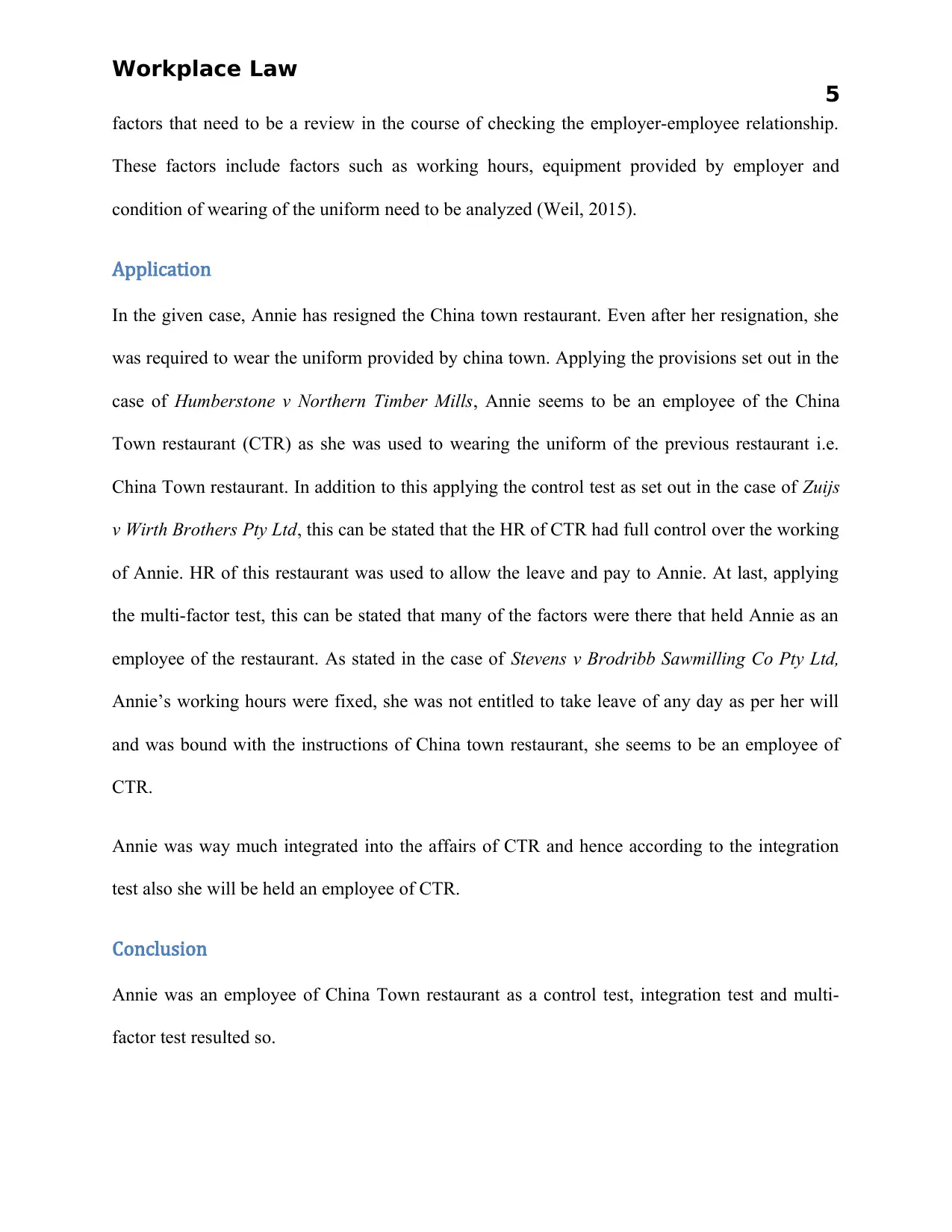
Workplace Law
5
factors that need to be a review in the course of checking the employer-employee relationship.
These factors include factors such as working hours, equipment provided by employer and
condition of wearing of the uniform need to be analyzed (Weil, 2015).
Application
In the given case, Annie has resigned the China town restaurant. Even after her resignation, she
was required to wear the uniform provided by china town. Applying the provisions set out in the
case of Humberstone v Northern Timber Mills, Annie seems to be an employee of the China
Town restaurant (CTR) as she was used to wearing the uniform of the previous restaurant i.e.
China Town restaurant. In addition to this applying the control test as set out in the case of Zuijs
v Wirth Brothers Pty Ltd, this can be stated that the HR of CTR had full control over the working
of Annie. HR of this restaurant was used to allow the leave and pay to Annie. At last, applying
the multi-factor test, this can be stated that many of the factors were there that held Annie as an
employee of the restaurant. As stated in the case of Stevens v Brodribb Sawmilling Co Pty Ltd,
Annie’s working hours were fixed, she was not entitled to take leave of any day as per her will
and was bound with the instructions of China town restaurant, she seems to be an employee of
CTR.
Annie was way much integrated into the affairs of CTR and hence according to the integration
test also she will be held an employee of CTR.
Conclusion
Annie was an employee of China Town restaurant as a control test, integration test and multi-
factor test resulted so.
5
factors that need to be a review in the course of checking the employer-employee relationship.
These factors include factors such as working hours, equipment provided by employer and
condition of wearing of the uniform need to be analyzed (Weil, 2015).
Application
In the given case, Annie has resigned the China town restaurant. Even after her resignation, she
was required to wear the uniform provided by china town. Applying the provisions set out in the
case of Humberstone v Northern Timber Mills, Annie seems to be an employee of the China
Town restaurant (CTR) as she was used to wearing the uniform of the previous restaurant i.e.
China Town restaurant. In addition to this applying the control test as set out in the case of Zuijs
v Wirth Brothers Pty Ltd, this can be stated that the HR of CTR had full control over the working
of Annie. HR of this restaurant was used to allow the leave and pay to Annie. At last, applying
the multi-factor test, this can be stated that many of the factors were there that held Annie as an
employee of the restaurant. As stated in the case of Stevens v Brodribb Sawmilling Co Pty Ltd,
Annie’s working hours were fixed, she was not entitled to take leave of any day as per her will
and was bound with the instructions of China town restaurant, she seems to be an employee of
CTR.
Annie was way much integrated into the affairs of CTR and hence according to the integration
test also she will be held an employee of CTR.
Conclusion
Annie was an employee of China Town restaurant as a control test, integration test and multi-
factor test resulted so.
⊘ This is a preview!⊘
Do you want full access?
Subscribe today to unlock all pages.

Trusted by 1+ million students worldwide
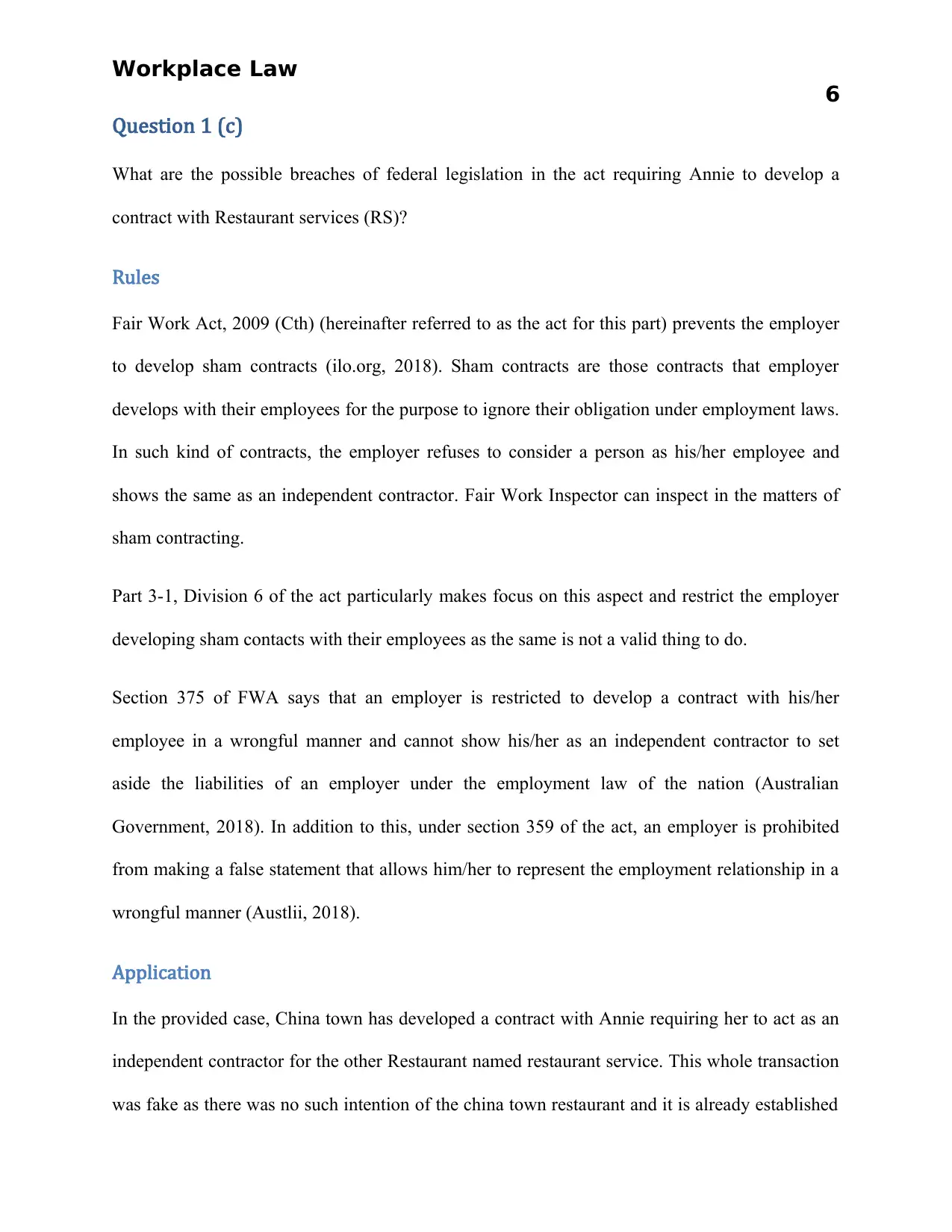
Workplace Law
6
Question 1 (c)
What are the possible breaches of federal legislation in the act requiring Annie to develop a
contract with Restaurant services (RS)?
Rules
Fair Work Act, 2009 (Cth) (hereinafter referred to as the act for this part) prevents the employer
to develop sham contracts (ilo.org, 2018). Sham contracts are those contracts that employer
develops with their employees for the purpose to ignore their obligation under employment laws.
In such kind of contracts, the employer refuses to consider a person as his/her employee and
shows the same as an independent contractor. Fair Work Inspector can inspect in the matters of
sham contracting.
Part 3-1, Division 6 of the act particularly makes focus on this aspect and restrict the employer
developing sham contacts with their employees as the same is not a valid thing to do.
Section 375 of FWA says that an employer is restricted to develop a contract with his/her
employee in a wrongful manner and cannot show his/her as an independent contractor to set
aside the liabilities of an employer under the employment law of the nation (Australian
Government, 2018). In addition to this, under section 359 of the act, an employer is prohibited
from making a false statement that allows him/her to represent the employment relationship in a
wrongful manner (Austlii, 2018).
Application
In the provided case, China town has developed a contract with Annie requiring her to act as an
independent contractor for the other Restaurant named restaurant service. This whole transaction
was fake as there was no such intention of the china town restaurant and it is already established
6
Question 1 (c)
What are the possible breaches of federal legislation in the act requiring Annie to develop a
contract with Restaurant services (RS)?
Rules
Fair Work Act, 2009 (Cth) (hereinafter referred to as the act for this part) prevents the employer
to develop sham contracts (ilo.org, 2018). Sham contracts are those contracts that employer
develops with their employees for the purpose to ignore their obligation under employment laws.
In such kind of contracts, the employer refuses to consider a person as his/her employee and
shows the same as an independent contractor. Fair Work Inspector can inspect in the matters of
sham contracting.
Part 3-1, Division 6 of the act particularly makes focus on this aspect and restrict the employer
developing sham contacts with their employees as the same is not a valid thing to do.
Section 375 of FWA says that an employer is restricted to develop a contract with his/her
employee in a wrongful manner and cannot show his/her as an independent contractor to set
aside the liabilities of an employer under the employment law of the nation (Australian
Government, 2018). In addition to this, under section 359 of the act, an employer is prohibited
from making a false statement that allows him/her to represent the employment relationship in a
wrongful manner (Austlii, 2018).
Application
In the provided case, China town has developed a contract with Annie requiring her to act as an
independent contractor for the other Restaurant named restaurant service. This whole transaction
was fake as there was no such intention of the china town restaurant and it is already established
Paraphrase This Document
Need a fresh take? Get an instant paraphrase of this document with our AI Paraphraser

Workplace Law
7
that Annie was an employee of CTR. The motive behind the development of the subjective
contract was to ignore the liability of china town restaurant as an employer of Annie. Applying
the provisions of section 357 of the act, this was a clear breach of the provision of the act as CTR
developed an arrangement in a wrongful manner with it is employee Annie. In addition to this,
CTR also breached the provision as laid down in the section 359 as it has made a false statement
to Annie and told her that even after the development of new arrangement with restaurant
service, nothing would change whereas, in actual, Annie’s pay was affected cause of her contract
with restaurant services.
Conclusion
China town restaurant has breached the provisions of the Fair Work Act, 2009 under section 357
and 359 and in this manner; the restaurant was involved in the breach of federal legislation.
7
that Annie was an employee of CTR. The motive behind the development of the subjective
contract was to ignore the liability of china town restaurant as an employer of Annie. Applying
the provisions of section 357 of the act, this was a clear breach of the provision of the act as CTR
developed an arrangement in a wrongful manner with it is employee Annie. In addition to this,
CTR also breached the provision as laid down in the section 359 as it has made a false statement
to Annie and told her that even after the development of new arrangement with restaurant
service, nothing would change whereas, in actual, Annie’s pay was affected cause of her contract
with restaurant services.
Conclusion
China town restaurant has breached the provisions of the Fair Work Act, 2009 under section 357
and 359 and in this manner; the restaurant was involved in the breach of federal legislation.
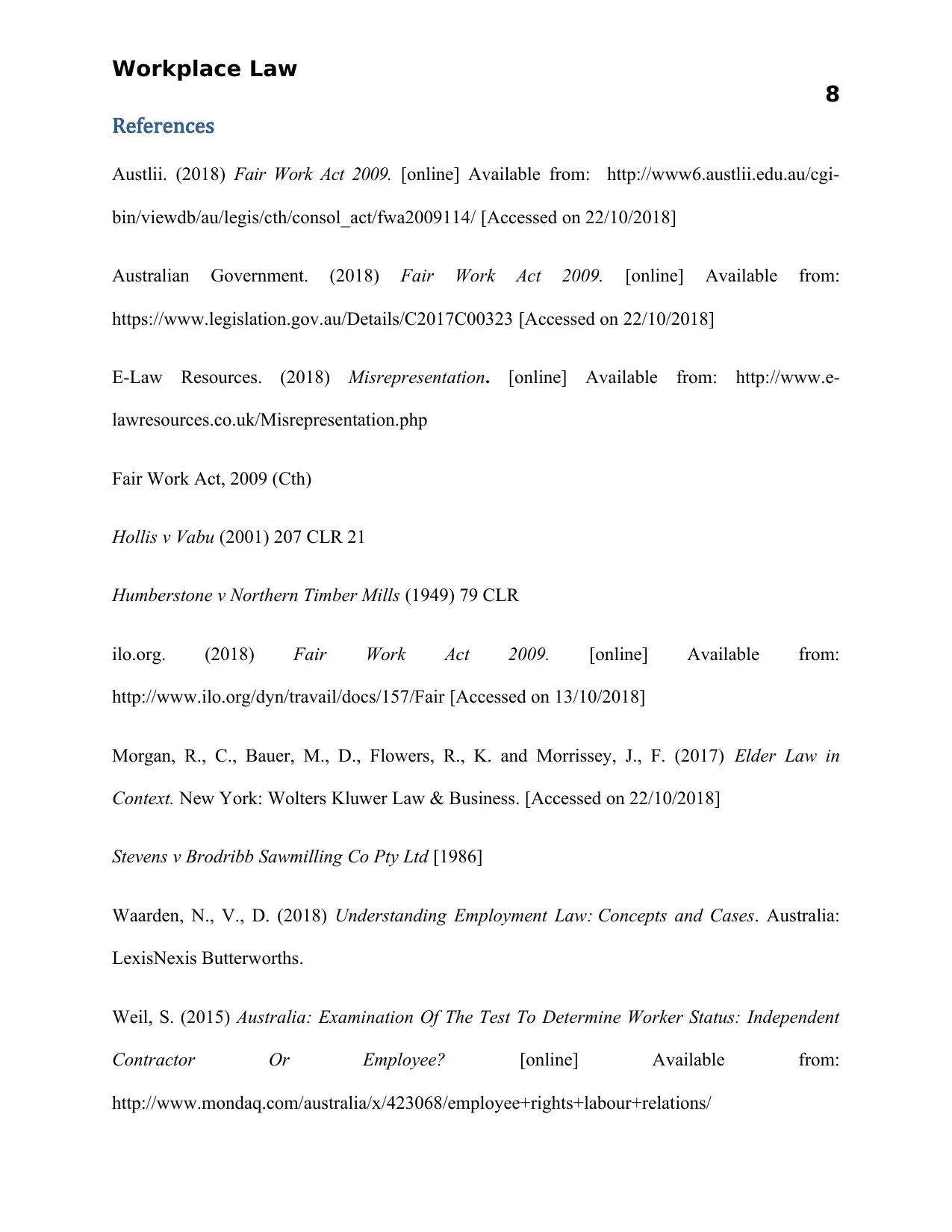
Workplace Law
8
References
Austlii. (2018) Fair Work Act 2009. [online] Available from: http://www6.austlii.edu.au/cgi-
bin/viewdb/au/legis/cth/consol_act/fwa2009114/ [Accessed on 22/10/2018]
Australian Government. (2018) Fair Work Act 2009. [online] Available from:
https://www.legislation.gov.au/Details/C2017C00323 [Accessed on 22/10/2018]
E-Law Resources. (2018) Misrepresentation. [online] Available from: http://www.e-
lawresources.co.uk/Misrepresentation.php
Fair Work Act, 2009 (Cth)
Hollis v Vabu (2001) 207 CLR 21
Humberstone v Northern Timber Mills (1949) 79 CLR
ilo.org. (2018) Fair Work Act 2009. [online] Available from:
http://www.ilo.org/dyn/travail/docs/157/Fair [Accessed on 13/10/2018]
Morgan, R., C., Bauer, M., D., Flowers, R., K. and Morrissey, J., F. (2017) Elder Law in
Context. New York: Wolters Kluwer Law & Business. [Accessed on 22/10/2018]
Stevens v Brodribb Sawmilling Co Pty Ltd [1986]
Waarden, N., V., D. (2018) Understanding Employment Law: Concepts and Cases. Australia:
LexisNexis Butterworths.
Weil, S. (2015) Australia: Examination Of The Test To Determine Worker Status: Independent
Contractor Or Employee? [online] Available from:
http://www.mondaq.com/australia/x/423068/employee+rights+labour+relations/
8
References
Austlii. (2018) Fair Work Act 2009. [online] Available from: http://www6.austlii.edu.au/cgi-
bin/viewdb/au/legis/cth/consol_act/fwa2009114/ [Accessed on 22/10/2018]
Australian Government. (2018) Fair Work Act 2009. [online] Available from:
https://www.legislation.gov.au/Details/C2017C00323 [Accessed on 22/10/2018]
E-Law Resources. (2018) Misrepresentation. [online] Available from: http://www.e-
lawresources.co.uk/Misrepresentation.php
Fair Work Act, 2009 (Cth)
Hollis v Vabu (2001) 207 CLR 21
Humberstone v Northern Timber Mills (1949) 79 CLR
ilo.org. (2018) Fair Work Act 2009. [online] Available from:
http://www.ilo.org/dyn/travail/docs/157/Fair [Accessed on 13/10/2018]
Morgan, R., C., Bauer, M., D., Flowers, R., K. and Morrissey, J., F. (2017) Elder Law in
Context. New York: Wolters Kluwer Law & Business. [Accessed on 22/10/2018]
Stevens v Brodribb Sawmilling Co Pty Ltd [1986]
Waarden, N., V., D. (2018) Understanding Employment Law: Concepts and Cases. Australia:
LexisNexis Butterworths.
Weil, S. (2015) Australia: Examination Of The Test To Determine Worker Status: Independent
Contractor Or Employee? [online] Available from:
http://www.mondaq.com/australia/x/423068/employee+rights+labour+relations/
⊘ This is a preview!⊘
Do you want full access?
Subscribe today to unlock all pages.

Trusted by 1+ million students worldwide

Workplace Law
9
Examination+Of+The+Test+To+Determine+Worker+Status+Independent+Contractor+Or+Empl
oyee
Young, C. (2018) Legal Tests to Determine Contract OF/FOR Services. [online] Available from:
http://www.academia.edu/8848818/Legal_Tests_to_Determine_Contract_OF_FOR_Services
[Accessed on 13/10/2018]
Zuijs v Wirth Brothers Pty Ltd [1955] HCA 73
9
Examination+Of+The+Test+To+Determine+Worker+Status+Independent+Contractor+Or+Empl
oyee
Young, C. (2018) Legal Tests to Determine Contract OF/FOR Services. [online] Available from:
http://www.academia.edu/8848818/Legal_Tests_to_Determine_Contract_OF_FOR_Services
[Accessed on 13/10/2018]
Zuijs v Wirth Brothers Pty Ltd [1955] HCA 73
1 out of 10
Related Documents
Your All-in-One AI-Powered Toolkit for Academic Success.
+13062052269
info@desklib.com
Available 24*7 on WhatsApp / Email
![[object Object]](/_next/static/media/star-bottom.7253800d.svg)
Unlock your academic potential
Copyright © 2020–2025 A2Z Services. All Rights Reserved. Developed and managed by ZUCOL.





![Management Law 2 Assignment - [University Name] - Semester 2](/_next/image/?url=https%3A%2F%2Fdesklib.com%2Fmedia%2Fimages%2Foc%2F38e706355e0d4bf19ce1377653715513.jpg&w=256&q=75)